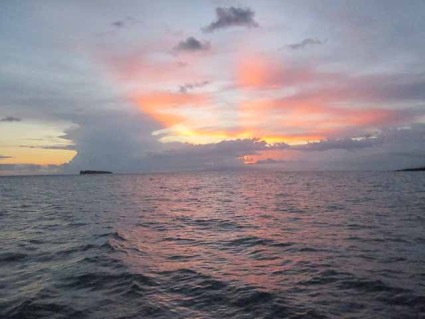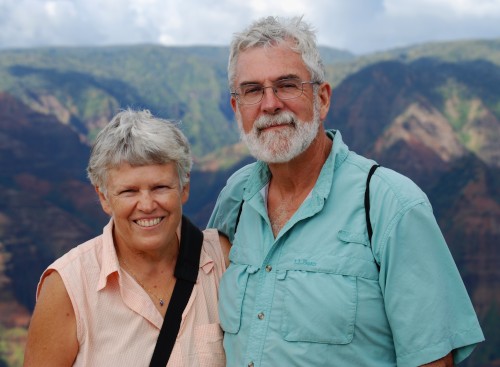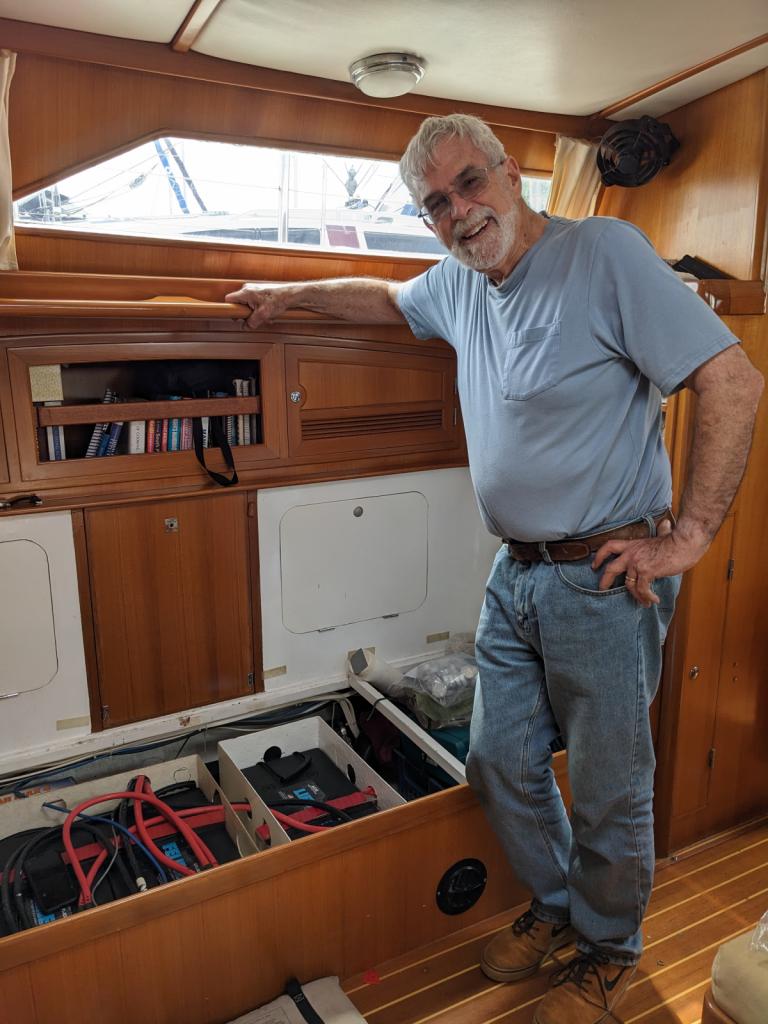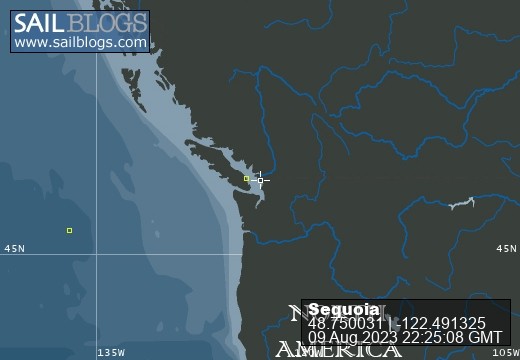
Sequoia Changing Latitudes
30 August 2023 | St. Helens, Oregon
09 August 2023 | Bellingham, Washington
21 July 2023 | Boat: Bellingham; C&B: Scappoose
10 July 2023 | Egmont, Sunshine Coast, B.C., Canada
02 July 2023 | Walsh Cove, Desolation Sound, B.C., Canada
23 June 2023 | Westview/Powell River B.C.
18 June 2023 | Ganges, Saltspring Island, B.C., Canada
22 June 2019 | Scappoose, Oregon
27 May 2019 | Back home in Oregon
09 May 2019 | Villas Alturas Hotel, Costa Rica
02 May 2019 | San Vito, Costa Rica
23 April 2019 | Golfito, Costa Rica
11 April 2019 | Panama City, Panama
04 April 2019 | Shelter Bay Marina, Colon, Panama
22 March 2019 | Jamaica
11 March 2019 | Zar Par Marina, Boca Chica, Dominican Republic
18 February 2019 | Culebra Island, Puerto Rico
31 January 2019 | Simpson Bay Lagoon, Sint Maarten
21 January 2019 | Nelson's Dockyard, English Harbour, Antigua
04 January 2019 | Portsmouth, Dominica
Westward Ho: Molokini, Lahaina, Honolua Bay
12 June 2011 | Maui, Hawaii
Barbara/windy

When I last wrote, we were still in Hilo, waiting for the trade winds to drop sufficiently that we could comfortably make passage across the Alenuihaha Channel to Maui. As it happens, now we are at the west end of Maui, waiting for the trade winds to drop sufficiently that we can comfortably make passage across the Pailolo Channel to Molokai. Hmmm… Something sounds familiar about this….
Before we left Hilo, we took one last car trip, down to the south end of the Big Island – southernmost point in the United States. The narrow road down to South Point crosses a windy plain, with grazing cattle, horses, and satellite tracking dishes. There are several rows of defunct wind generators, missing some of their arms, and dripping rust. It’s really a disheartening sight, reminiscent of the space junk so prominent in the first Star Wars movie. Beyond the defunct wind generators are rows of modern, much bigger wind generators, looking sleek, efficient and distant. And there’s plenty of wind to make them all go around.
At South Point, the road peters out, and there are dozens of fishermen, casting their lines off the big cliffs. They have tents and porta-potties staked against the wind, and look like they are there for the long term. There were no women among the fishers. Many of the men had the look of rebellious, testosterone-heavy youth, or older substance abuse-compromised homeless people. We watched one young man on a rock out in the surf, at times up to his knees in crashing waves, casting his line out into the ocean, while his friend hung onto a rope anchored into the rock. In the rocks above the young man was a sign advising that this was the site of “canoe mooring holes.” Indeed, we saw numerous examples of holes cut into the lava rock, presumably where canoes could be tied. But the surf was so rough, it was hard to imagine that any canoe could tie up there without assured destruction.
Leaving Radio Bay in Hilo was slightly more hassle than we had anticipated. The dinghy had been in the water for three weeks, and even though we washed it off mid-way through our stay, the bottom was thoroughly slimy. We couldn’t put it away like that, so we spent considerable time scrubbing it down with various anti-slime agents that really didn’t work too well. We finally rolled it up and put it away, and haven’t had it out again since. It remains to be seen (or smelled) how successful our clean-up was. The anchor chain and anchor also proved to be totally encrusted with mud, slime, rust and very sharp little barnacles. Again, you can’t put those away without cleaning all that off, or suffer the olfactory consequences when you open the anchor locker. Not sure where all that rust came from – the chain is galvanized, so there must be something very big and very rusty on the bottom of Radio Bay.
We finally headed out of Radio Bay late in the afternoon of June 3, and motored north, rounding the north end of the Big Island during the night, and crossing the Alenuihaha Channel the next morning. Yes, it was rough, but it was manageable. By midday we were at anchor in Makena Bay, where it was relatively calm, and we went to sleep. We were awakened an hour or so later when the wind came up, waves were reaching 3-4 feet, and our anchor was dragging. We moved to the other side of the point (in front of Big Beach) and found a satisfactory, but somewhat rolly anchorage for the night.
We weren’t far from Molokini, a half sunken crater which is a snorkeling destination. You’re not allowed to anchor, but there are mooring buoys six feet underwater. In the morning we motored the twenty minutes to get there, located a buoy and Craig dove down and retrieved it. After tying off our bow line, we spent an hour snorkeling with the tourists (there were MANY tourists there, on many excursion boats). The coral is in good condition, but we didn’t see all that many fish – I think we’ve been spoiled by all the good snorkeling in the South Pacific.
That night, we caught a mooring buoy off Lahaina. This one was nowhere near as easy as the Molokini buoy. It was floating on the surface, but crusted with nasty sharp barnacles, and streaming in a strong current. First try, Craig caught it with the boat hook, but the boat swung around in the current, capturing the boat hook between the buoy and the bow of the boat, and bending the boat hook into oblivion. The handle of the boat hook came off (bent boat hook still attached to buoy) and the boat drifted away. Next try, Craig managed to get a rope through a link of the chain, and worried about chafe in the strong current (which was flowing contrary to the wind, of course) finally wound up deploying our storm rode lead over the anchor platform: five feet of 5/8 inch chain with a heavy canvas hose cover, to connect to the mooring rope.
After all that, the waves made the moorage a very rolly experience. We deployed the “flopper stopper” but even so, it was not a comfortable night. The next morning we talked to the harbormaster in Lahaina, and were able to get a slip inside the harbor. Not the best situation – we were rafted onto another boat, and the finger pier they were tied to was reportedly damaged in the March tsunami. But it worked for us, and we were able to stay for four days. Our friends on Ka’sala were there in the harbor, and we also saw the folks from Midnight Blue and Dog Star (we first met all these folks in Mexico). We spent time with some of these friends, and also explored on our own. There were lots of historic sites to see, lots of good (and expensive) restaurants. We rented bikes one day and explored a bit further.
Yesterday, we left Lahaina and motored up the coast of Maui to Honolua Bay, where we are now. The trade winds are howling across the bay, but that doesn’t stop the big tourist excursion boats which come here with hundreds of would-be snorkelers. More snorkelers enter the bay from the shore. There’s a big sea turtle who evidently lives close by where we are anchored. We saw him when we came in, and we’ve heard numerous snorkelers commenting that they saw a turtle. Our anchor has completely buried itself in the sand – something that’s easy to see in 35 feet of very clear water. We went snorkeling today, both to check the anchor, and just to look at the coral and the fish. There are many different varieties of fish here, although still not the abundance we saw in the South Pacific. We’ll keep looking!
Besides the tourist boats, there have been two other sailboats here. One, Libertatia, is a 1935 wooden boat, Ed Monk’s first design, partly square rigged, which a group of young guys bought for a song in Seattle and restored. When we first arrived, Lowell and Jenine swam over to greet us, bringing a nice bunch of Hawaiian bananas. We spent an hour or so talking with them, and hearing their plans for heading to the South Pacific and beyond. They have an interesting website: www.libertatiavoyage.blogspot.com
Tomorrow we expect to cross the Pailolo channel over to Molokai, an island that reportedly doesn’t get much tourist traffic. We’re looking forward to that!
Before we left Hilo, we took one last car trip, down to the south end of the Big Island – southernmost point in the United States. The narrow road down to South Point crosses a windy plain, with grazing cattle, horses, and satellite tracking dishes. There are several rows of defunct wind generators, missing some of their arms, and dripping rust. It’s really a disheartening sight, reminiscent of the space junk so prominent in the first Star Wars movie. Beyond the defunct wind generators are rows of modern, much bigger wind generators, looking sleek, efficient and distant. And there’s plenty of wind to make them all go around.
At South Point, the road peters out, and there are dozens of fishermen, casting their lines off the big cliffs. They have tents and porta-potties staked against the wind, and look like they are there for the long term. There were no women among the fishers. Many of the men had the look of rebellious, testosterone-heavy youth, or older substance abuse-compromised homeless people. We watched one young man on a rock out in the surf, at times up to his knees in crashing waves, casting his line out into the ocean, while his friend hung onto a rope anchored into the rock. In the rocks above the young man was a sign advising that this was the site of “canoe mooring holes.” Indeed, we saw numerous examples of holes cut into the lava rock, presumably where canoes could be tied. But the surf was so rough, it was hard to imagine that any canoe could tie up there without assured destruction.
Leaving Radio Bay in Hilo was slightly more hassle than we had anticipated. The dinghy had been in the water for three weeks, and even though we washed it off mid-way through our stay, the bottom was thoroughly slimy. We couldn’t put it away like that, so we spent considerable time scrubbing it down with various anti-slime agents that really didn’t work too well. We finally rolled it up and put it away, and haven’t had it out again since. It remains to be seen (or smelled) how successful our clean-up was. The anchor chain and anchor also proved to be totally encrusted with mud, slime, rust and very sharp little barnacles. Again, you can’t put those away without cleaning all that off, or suffer the olfactory consequences when you open the anchor locker. Not sure where all that rust came from – the chain is galvanized, so there must be something very big and very rusty on the bottom of Radio Bay.
We finally headed out of Radio Bay late in the afternoon of June 3, and motored north, rounding the north end of the Big Island during the night, and crossing the Alenuihaha Channel the next morning. Yes, it was rough, but it was manageable. By midday we were at anchor in Makena Bay, where it was relatively calm, and we went to sleep. We were awakened an hour or so later when the wind came up, waves were reaching 3-4 feet, and our anchor was dragging. We moved to the other side of the point (in front of Big Beach) and found a satisfactory, but somewhat rolly anchorage for the night.
We weren’t far from Molokini, a half sunken crater which is a snorkeling destination. You’re not allowed to anchor, but there are mooring buoys six feet underwater. In the morning we motored the twenty minutes to get there, located a buoy and Craig dove down and retrieved it. After tying off our bow line, we spent an hour snorkeling with the tourists (there were MANY tourists there, on many excursion boats). The coral is in good condition, but we didn’t see all that many fish – I think we’ve been spoiled by all the good snorkeling in the South Pacific.
That night, we caught a mooring buoy off Lahaina. This one was nowhere near as easy as the Molokini buoy. It was floating on the surface, but crusted with nasty sharp barnacles, and streaming in a strong current. First try, Craig caught it with the boat hook, but the boat swung around in the current, capturing the boat hook between the buoy and the bow of the boat, and bending the boat hook into oblivion. The handle of the boat hook came off (bent boat hook still attached to buoy) and the boat drifted away. Next try, Craig managed to get a rope through a link of the chain, and worried about chafe in the strong current (which was flowing contrary to the wind, of course) finally wound up deploying our storm rode lead over the anchor platform: five feet of 5/8 inch chain with a heavy canvas hose cover, to connect to the mooring rope.
After all that, the waves made the moorage a very rolly experience. We deployed the “flopper stopper” but even so, it was not a comfortable night. The next morning we talked to the harbormaster in Lahaina, and were able to get a slip inside the harbor. Not the best situation – we were rafted onto another boat, and the finger pier they were tied to was reportedly damaged in the March tsunami. But it worked for us, and we were able to stay for four days. Our friends on Ka’sala were there in the harbor, and we also saw the folks from Midnight Blue and Dog Star (we first met all these folks in Mexico). We spent time with some of these friends, and also explored on our own. There were lots of historic sites to see, lots of good (and expensive) restaurants. We rented bikes one day and explored a bit further.
Yesterday, we left Lahaina and motored up the coast of Maui to Honolua Bay, where we are now. The trade winds are howling across the bay, but that doesn’t stop the big tourist excursion boats which come here with hundreds of would-be snorkelers. More snorkelers enter the bay from the shore. There’s a big sea turtle who evidently lives close by where we are anchored. We saw him when we came in, and we’ve heard numerous snorkelers commenting that they saw a turtle. Our anchor has completely buried itself in the sand – something that’s easy to see in 35 feet of very clear water. We went snorkeling today, both to check the anchor, and just to look at the coral and the fish. There are many different varieties of fish here, although still not the abundance we saw in the South Pacific. We’ll keep looking!
Besides the tourist boats, there have been two other sailboats here. One, Libertatia, is a 1935 wooden boat, Ed Monk’s first design, partly square rigged, which a group of young guys bought for a song in Seattle and restored. When we first arrived, Lowell and Jenine swam over to greet us, bringing a nice bunch of Hawaiian bananas. We spent an hour or so talking with them, and hearing their plans for heading to the South Pacific and beyond. They have an interesting website: www.libertatiavoyage.blogspot.com
Tomorrow we expect to cross the Pailolo channel over to Molokai, an island that reportedly doesn’t get much tourist traffic. We’re looking forward to that!
Comments
| Vessel Name: | Sequoia |
| Vessel Make/Model: | Outbound 44 |
| Hailing Port: | Portland, Or |
| Crew: | Craig & Barbara Johnston |
| About: | |
| Extra: |
Sequoia's Photos - Main
Who we are...

Who: Craig & Barbara Johnston
Port: Portland, Or



